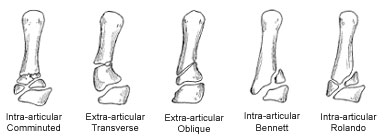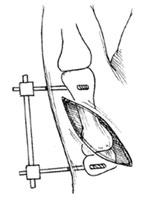
Thumb Fractures
A broken thumb is a serious problem. It affects the ability to grasp items. A broken thumb can increase the risk of arthritis later in life.
AnatomyThe thumb has two bones. The first bone (distal phalange) extends from the tip of the thumb to the knuckle. The second bone (proximal phalange) extends from the knuckle to the base of the thumb. This is the area of webbing between the thumb and the first finger. The thumb connects with a bone in the hand (first metacarpal).
DescriptionAlthough a break can occur in any of these bones, the most serious breaks happen near the joints. This is particularly true when the fracture occurs at the base of the thumb near the wrist.
There are specific types of thumb fractures, depending on the type of break. Bennett and Rolando fractures are breaks at the base of the thumb. They involve the joint between the thumb metacarpal and a specific wrist bone. Fractures that involve the joints are always more difficult to treat and are at increased risk of an unfavorable outcome.
 Classification of fractures of the thumb.
Reproduced with permission from Soyer AD: Fractures of the Base of the First Metacarpal: Current Treatment Options. J Am Acad Orthop Surg 1999;7:403-412.
Fractures can also occur in the long portion of the bone called the metacarpal shaft.
Cause
Classification of fractures of the thumb.
Reproduced with permission from Soyer AD: Fractures of the Base of the First Metacarpal: Current Treatment Options. J Am Acad Orthop Surg 1999;7:403-412.
Fractures can also occur in the long portion of the bone called the metacarpal shaft.
Cause
Thumb fractures are usually caused by direct stress, such as from a fall. A thumb fracture may happen when a ball catches and pulls the thumb back. Some fractures may be caused indirectly, from twisting or muscle contractions, as occur in wrestling, hockey, football, and skiing. People with a history of bone disease or calcium deficiency are especially at risk.
The risk of a thumb fracture can be lessened by using protective taping, padding, or other equipment. Developing strength in the hands through exercise and proper nutrition can also provide some protection.
Symptoms- Severe pain at the fracture site
- Swelling
- Limited or no ability to move the thumb
- Extreme tenderness
- A misshapen or deformed look to the thumb
- Numbness or coldness in the thumb
A doctor should be consulted as soon as possible if a thumb injury and suspected fracture has occurred. A delay in treatment may make it more difficult to align the bones properly, due to continued swelling, and may lead to a poor outcome. A padded splint can be used to prevent the bone from moving farther out of alignment. This is encouraged before treatment is finalized.
The physician will examine the injury, take a medical history, and order x-rays of the injury.
TreatmentNonsurgical Treatment
 A fracture of the thumb can be held in proper alignment using external fixation.
Reproduced with permission from Soyer AD: Fractures of the Base of the First Metacarpal: Current Treatment Options. J Am Acad Orthop Surg 1999;7:403-412.
If the bone fragments of the fracture have not moved (displaced) very much, or if the break is located in the middle (shaft) of the bone, your surgeon may be able to use a specially designed cast (spica cast) to hold the bone fragments in place. The cast may need to be worn for at least 4 to 6 weeks. During that time, regular X-rays may be needed to ensure that the bone has not slipped out of alignment.
A fracture of the thumb can be held in proper alignment using external fixation.
Reproduced with permission from Soyer AD: Fractures of the Base of the First Metacarpal: Current Treatment Options. J Am Acad Orthop Surg 1999;7:403-412.
If the bone fragments of the fracture have not moved (displaced) very much, or if the break is located in the middle (shaft) of the bone, your surgeon may be able to use a specially designed cast (spica cast) to hold the bone fragments in place. The cast may need to be worn for at least 4 to 6 weeks. During that time, regular X-rays may be needed to ensure that the bone has not slipped out of alignment.
Surgical Treatment
Surgery may be needed, depending on the location of the fracture and the amount of movement between the broken fragments of bone. Your surgeon may use one of several operative fixation techniques to realign the bone fragments. These fragments must be held in place while the bone heals.
These techniques include devices that hold the bone fragments in place either inside the body (internal fixation) or outside the body (external fixation). Internal fixation techniques include the use of wire, pins, plates, and screws. External fixation techniques include the use of pins in bone that are held in place through their attachment to an external fixation device.
A cast or splint will be worn for 2 to 6 weeks after surgery. When the cast is removed, hand therapy may be recommended in order to restore movement. It can take 3 months or more to regain full use of the hand, depending on the severity of the injury.
OutcomeIf the bones remain in a stable position, thumb fractures generally heal well. There is a possibility of infection and tenderness around the surgical site and around the pins, if external fixation is used. As with all joint injuries, there is an increased tendency to develop arthritis following a thumb fracture, which can limit motion and reduce strength in the thumb.
To help restore motion, soak the hand in warm water. While soaking the hand, exercise the thumb by moving it in a circular motion and by touching the little finger to the thumb. Strength can be improved through regular use of a spring-type hand squeezer.
Source: http://orthoinfo.aaos.org/topic.cfm?topic=A00011
